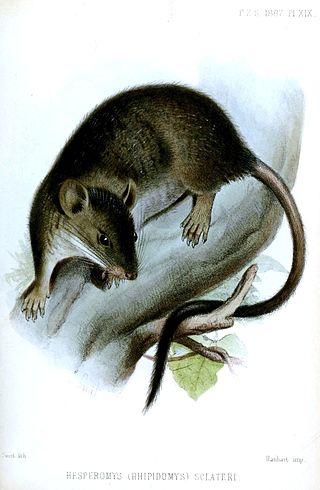
Ceará is one of the 26 states of Brazil, located in the northeastern part of the country, on the Atlantic coast. It is the eighth-largest Brazilian State by population and the 17th by area. It is also one of the main tourist destinations in Brazil. The state capital is the city of Fortaleza, the country's fourth most populous city. The state has 4.3% of the Brazilian population and produces 2.1% of the Brazilian GDP.

Crato is a city of 130,000 inhabitants on the banks of the river Granjeiro in the south of the state of Ceará, in the northeast of Brazil. It was founded on June 21, 1764 by the Capuchin friar Carlos Maria de Ferrara. Originally it was a small village in which the population were principally native Kariris, it gained official status as a city on October 17, 1817.

The rodent subfamily Sigmodontinae includes New World rats and mice, with at least 376 species. Many authorities include the Neotominae and Tylomyinae as part of a larger definition of Sigmodontinae. When those genera are included, the species count numbers at least 508. Their distribution includes much of the New World, but the genera are predominantly South American, such as brucies. They invaded South America from Central America as part of the Great American Interchange near the end of the Miocene, about 5 million years ago. Sigmodontines proceeded to diversify explosively in the formerly isolated continent. They inhabit many of the same ecological niches that the Murinae occupy in the Old World.

The Trans-Amazonian Highway was introduced on September 27, 1972. It is 4,000 km long, making it the third longest highway in Brazil. It runs through the Amazon forest and the Brazilian states of Paraíba, Ceará, Piauí, Maranhão, Tocantins, Pará and Amazonas, from the proximities of Saboeiro up until the town of Lábrea.
The splendid climbing mouse is a rodent species from South America. It is found in Brazil, French Guiana, Guyana, Suriname and Venezuela.

Rhipidomys is a genus of rodents in the family Cricetidae, The following 25 species of climbing mouse species are currently recognised:

The Caatinga enclaves moist forests is an ecoregion of the Tropical moist forests Biome, and the South American Atlantic Forest biome. It is located in northeastern Brazil.

The rufous-breasted leaftosser is a species of bird in the subfamily Sclerurinae, the leaftossers and miners, of the ovenbird family Furnariidae. It is found in Argentina, Brazil, and Paraguay.

Caatinga is a type of semi-arid tropical vegetation, and an ecoregion characterized by this vegetation in interior northeastern Brazil. The name "Caatinga" is a Tupi word meaning "white forest" or "white vegetation" . The Caatinga is a xeric shrubland and thorn forest, which consists primarily of small, thorny trees that shed their leaves seasonally. Cacti, thick-stemmed plants, thorny brush, and arid-adapted grasses make up the ground layer. Most vegetation experiences a brief burst of activity during the three-month long rainy season.

Cearachelys is an extinct genus of pleurodiran turtle which existed some 110 million years ago. The genus is monotypic, with only type species Cearachelys placidoi known.

The Atlantic Forest climbing mouse is an arboreal rodent species in the family Cricetidae from South America. It is found in the Atlantic Forest of southeastern Brazil at elevations from sea level to 1500 m. It utilizes the ground more than the understory in isolated forests however this utilization changes in certain areas of the Atlantic Forest where it prefers to use the vegetation canopy. Its karyotype is 2n = 44, FN = 74–80.

Santana do Cariri is a municipality in the state of Ceará in the Northeast region of Brazil. It is located in the immediate and intermediate region of Juazeiro do Norte, as well as in the region of influence of Juazeiro do Norte.The municipality has 807 km2. It is estimated that in 2021 its population has reached 17,726 thousand inhabitants, according to the IBGE. It has the title of “The Cearense Capital of Paleontology ''.
Caririaçu is a municipality in the state of Ceará in the northeast region of Brazil. It is located in the Caririaçu Microregion, part of the Cariri Metropolitan Region, in the southern mesoregion of Ceará. According to the Brazilian Institute of Geography and Statistics, its estimated population for 2018 was 27,095 inhabitants.
Tarairiú is an extinct and very poorly known language of eastern Brazil. The Tarairiu nation was divided into several tribes: the Janduí, Kanindé, Paiaku, Jenipapo, Jenipabuçu, Javó, Kamaçu, Tukuriju, Ariu, and "Xukuru" / Xacó.

Nova Olinda is a municipality of the Northeastern state of Ceará in Brazil. It is located in the micro-region of Cariri, mesoregion of Southern Cearense, Metropolitan Region of Cariri. Its population is 15,798 inhabitants, as estimated by the IBGE in 2021.[2] It was created in 1957 and its area is 284,404 km².
Cariri Metro is a 13.9-kilometer (8.6 mi), nine station diesel commuter rail line in the Cariri region of southern Ceará state, Brazil. It is operated by Companhia Cearense de Transportes Metropolitanos, which also operates the Fortaleza Metro. It is expected to transport about 5,000 passengers per day. The line went into operation on an experimental basis on 1 December 2009, and went into regular service in 2010.

Maaradactylus is a genus of anhanguerid pterodactyloid pterosaur known from the Lower Cretaceous period of the Romualdo Formation of northeastern Brazil.

The Federal University of Cariri is a Brazilian federal public higher education institution, created in 2013 and based in the city of Juazeiro do Norte, in the state of Ceará. It has campus in the cities of Crato, Barbalha, Brejo Santo and Icó.
Francisco Vítor Silva Costa, known as Vítor Jacaré or just Jacaré, is a Brazilian footballer who plays as a forward for América Mineiro.














